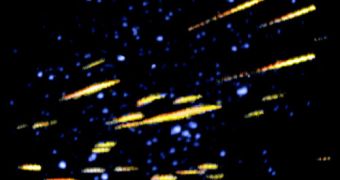August will be a good month for skywatchers around the world, as the most important meteor shower of the year will put an impressive show, with dozens of shooting stars being expected each hour in the night sky.
The best thing about the annual Perseid meteor shower is the fact that the Moon - space bane of meteor watchers for its tendency to wash out all but the brightest meteors - will be out of the way during the shower's peak, making the night sky ideal for observations.
The Perseid is probably the most prolific meteor shower, fueled by the comet Swift-Tuttle along the orbit of which many meteorites will move through a stream, most visible from the Northern Hemisphere.
During the peak, rates of a hundred or more meteors per hour can be observed. With the Moon out of the way, the best place to enjoy the show in the sky is a point far outside any large cities, where stars are not dimmed by light pollution.
"It's going to be a great show," said Bill Cooke of NASA's Meteoroid Environment Office at the Marshall Space Flight Center in Alabama. "The Moon is new on August 12, which means no moonlight, dark skies and plenty of meteors."
Appearing to emanate from the constellation Perseus - hence the name - the shower will reach its peak late night August 12 through August 13, on the northeast horizon. There will be need to bring binoculars and powerful telescopes, since, due to the high speed of the meteorites, they will be best observed with the naked eye.
"The August Perseids are among the strongest of the readily observed annual meteor showers, and at maximum activity nominally yield 90 or 100 meteors per hour," said Joe Rao, SPACE.com's Skywatching columnist. "However, observers with exceptional skies often record even larger numbers."

 14 DAY TRIAL //
14 DAY TRIAL //